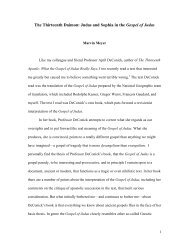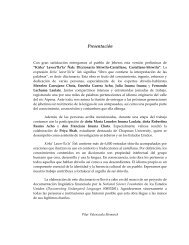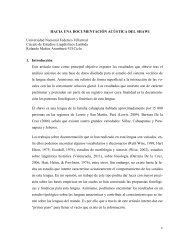“Surplus Humanity” and the Margins of Legality - Chapman University
“Surplus Humanity” and the Margins of Legality - Chapman University
“Surplus Humanity” and the Margins of Legality - Chapman University
Create successful ePaper yourself
Turn your PDF publications into a flip-book with our unique Google optimized e-Paper software.
Do Not Delete 12/12/2010 7:34 PM<br />
28 <strong>Chapman</strong> Law Review [Vol. 14:1<br />
states have been far more effective in <strong>the</strong> destruction <strong>of</strong> mass<br />
housing than in its construction.‖ 179<br />
Parallel with <strong>the</strong> neoliberal reordering <strong>of</strong> global production<br />
<strong>and</strong> accumulation, cities are becoming a primary arena <strong>of</strong> <strong>the</strong><br />
convergence between <strong>the</strong> domains <strong>of</strong> economy <strong>and</strong> culture. 180<br />
Accordingly, a confluence <strong>of</strong> reconfiguration <strong>of</strong> urban space <strong>and</strong><br />
commodification <strong>of</strong> symbolic forms is underway. 181 A remarkable<br />
feature <strong>of</strong> post-Fordist production systems is <strong>the</strong> increasing<br />
significance <strong>of</strong> production <strong>and</strong> consumption <strong>of</strong> cultural<br />
products. 182 In <strong>the</strong> new economic geography <strong>of</strong> capital<br />
accumulation, Fordist mass production is increasingly moved to<br />
low wage areas, usually away from urban centers, both globally<br />
<strong>and</strong> nationally. 183 As a result, <strong>the</strong> city becomes exclusively a zone<br />
<strong>of</strong> <strong>the</strong> service <strong>and</strong> consumption economy, <strong>and</strong> urban space itself<br />
turns into a cultural commodity to be consumed along market<br />
principles. 184 Skills suitable for <strong>the</strong> service sector <strong>and</strong>/or <strong>the</strong><br />
capacity to consume what this space has to <strong>of</strong>fer become <strong>the</strong> only<br />
grounds for eligibility to be in <strong>the</strong> city. Deindustrialization <strong>and</strong><br />
flight <strong>of</strong> <strong>the</strong> ineligible <strong>of</strong>ten leave in <strong>the</strong>ir wake ―dead zones‖ that<br />
become ―developers‘ utopias‖ or ―privatopias.‖ 185 The ineligible<br />
who choose to stay back are eventually confined to <strong>the</strong> informal<br />
economy <strong>and</strong> deprived <strong>of</strong> secure shelter. The commodification <strong>of</strong><br />
urban space, with culture <strong>and</strong> aes<strong>the</strong>tics at a premium,<br />
disciplines <strong>the</strong> ineligible <strong>and</strong> <strong>the</strong> dispossessed through a range <strong>of</strong><br />
legal <strong>and</strong> architectural measures. These include ―secure<br />
architecture,‖ ―zero tolerance policing,‖ <strong>and</strong> ―preemptive crime<br />
control,‖ in <strong>the</strong> neoliberal ―post-justice‖ city. 186<br />
179 Berner, Learning from Informal Markets, supra note 38, at 295.<br />
180 For transformative impacts <strong>of</strong> neoliberal globalization on urban spaces around <strong>the</strong><br />
world, see Swapna Banerjee-Guha, Introduction, in ACCUMULATION BY DISPOSSESSION:<br />
TRANSFORMATIVE CITIES IN THE NEW GLOBAL ORDER 1, 1–5 (Swapna Banerjee-Guha ed.,<br />
2010) [hereinafter ACCUMULATION BY DISPOSSESSION]; William Sites, Primitive<br />
Globalization? State <strong>and</strong> Locale in Neoliberal Global Engagement, 18 SOC. THEORY 121,<br />
128 (2000).<br />
181 For a thoughtful survey, see generally Allen J. Scott, Capitalism, Cities, <strong>and</strong> <strong>the</strong><br />
Production <strong>of</strong> Symbolic Forms, 26 TRANSACTIONS OF THE INST. BRIT. GEOGRAPHERS 11<br />
(2001), available at http://onlinelibrary.wiley.com/doi/10.1111/1475-5661.00003/abstract.<br />
182 Id. at 16.<br />
183 Douglas S. Massey, Social Structure, Household Strategies, <strong>and</strong> <strong>the</strong> Cumulative<br />
Causation <strong>of</strong> Migration, 56 POPULATION INDEX 3, 14–17 (1990), available at<br />
http://www.jstor.org/stable/3644185.<br />
184 See generally Timothy A. Gibson, Selling City Living: Urban Br<strong>and</strong>ing<br />
Campaigns, Class Power <strong>and</strong> <strong>the</strong> Civic Good, 8 INT‘L J. CULTURAL STUD. 259 (2005).<br />
185 Gordon MacLeod et al., Negotiating <strong>the</strong> Contemporary City: Introduction, 40 URB.<br />
STUD. 1655, 1656 (2003) (citation omitted). See also Henry W. McGee, Jr., Seattle's<br />
Central District, 1990–2006: Integration <strong>of</strong> Displacement?, 39 URB. LAW. 167, 169–71<br />
(2007).<br />
186 See Don Mitchell, Postmodern Geographical Praxis? The Postmodern Impulse <strong>and</strong><br />
<strong>the</strong> War Against Homeless People in <strong>the</strong> ‗Post-justice‘ City, in POSTMODERN GEOGRAPHY:<br />
THEORY AND PRAXIS 57, 77, 82 (Claudio Minca ed., 2001); Don Mitchell, The Annihilation
















